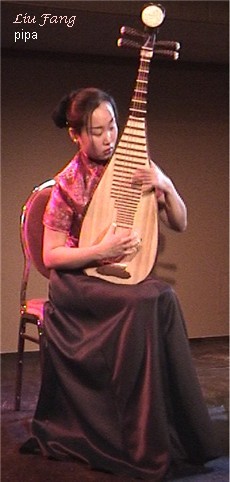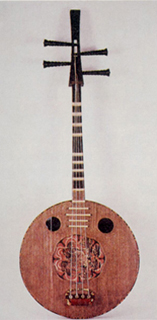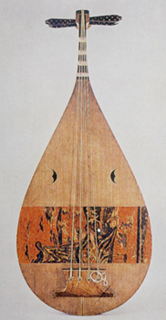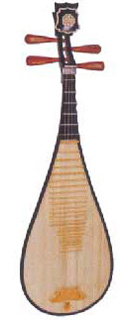
|
The historical development of the pipa has been a progressive process from its very beginning with few major fusions. The earliest Chinese written texts about the pipa dated back at least to the second century BC. For instance, Xi Liu of the Eastern Han Dynasty (25-220 AD) described in his book, The Definition of Terms - On Musical Instruments, that the name of the instrument pipa originally referred to two finger techniques. The two Chinese characters p'i and p'a stood originally for the two movements, i.e. plucking the strings forwards and backwards, respectively. It is commonly known now that it is the generic name for all pluck-string instruments of the ancient times. For instance, in the Qin Dynasty (222-207 BC), there had been a kind of plucked-instrument, known as xiantao, with a straight neck and a round sound-body played horizontally, which is considered a predecessor of the pipa. In the preface to his verse Ode to Pipa, Xuan Fu of the Jin Dynasty (265-420 AD) wrote: "...the pipa appeared in the late Qin period. When the people suffered from being forced to build the Great Wall, they played the instrument to express their resentment". By the Han Dynasty (206 BC -- 220 AD), the instrument developed into its form of four strings and twelve frets, plucked with fingernails and known as pipa or qin-pipa
Fig.1: Historical development of the pipa, a Chinese four stringed lute
|
|
 Hu stands for "foreign" in Chinese), which was played horizontally with a wooden plectrum (see the picture below for the Tang Dynasty pipa player). During the early Tang Dynasty, foreign music became very popular. A fusion of the original Chinese pipa and the "Hu pipa" took place such that the instrument gradually became what the present pipa looks like toward the middle of the Tang Dynasty (see the above Fig.1 [1]-[4] and the following Note 1). Meanwhile the playing method has been developed and repertoire increased. One of the greatest developments was that the left hand became totally free by holding the instrument vertically, i.e. the pipa rests on the thigh of the instrumentalist in an upright position, and was played vertically with five fingers of the right hand instead of horizontally with a plectrum (see the photo at the top of this page). Hu stands for "foreign" in Chinese), which was played horizontally with a wooden plectrum (see the picture below for the Tang Dynasty pipa player). During the early Tang Dynasty, foreign music became very popular. A fusion of the original Chinese pipa and the "Hu pipa" took place such that the instrument gradually became what the present pipa looks like toward the middle of the Tang Dynasty (see the above Fig.1 [1]-[4] and the following Note 1). Meanwhile the playing method has been developed and repertoire increased. One of the greatest developments was that the left hand became totally free by holding the instrument vertically, i.e. the pipa rests on the thigh of the instrumentalist in an upright position, and was played vertically with five fingers of the right hand instead of horizontally with a plectrum (see the photo at the top of this page).
The Tang pipa (Fig. 1[3]) was larger than the modern instrument. It usually had four or five strings and fewer frets (compared to the present day pipa). Probably influenced by the Hu pipa, the Tang pipa was often played with a wooden plectrum, a technique still used by its Japanese descendent, the biwa. Since the mid Tang Dynasty, and particularly since the Song Dynasty (960-1279), the instrument was gradually developed into the present form of a lute played with fingernails, while the techniques with the plectrum were totally abandoned. The strings of the instrument were made of silk. Musicians used their real nails of the right hand to pluck the strings. An exception to this is the Nanguan pipa which is popular in Fujian Province (South-East China) and Taiwan in a particular kind of traditional music called Nanguan which can be traced back to at least the Song Dynasty. Pipa players in the Nanguan tradition play the pipa horizontally and use a one piece plectrum just like the Tang pipa. |
























0 comments:
Post a Comment